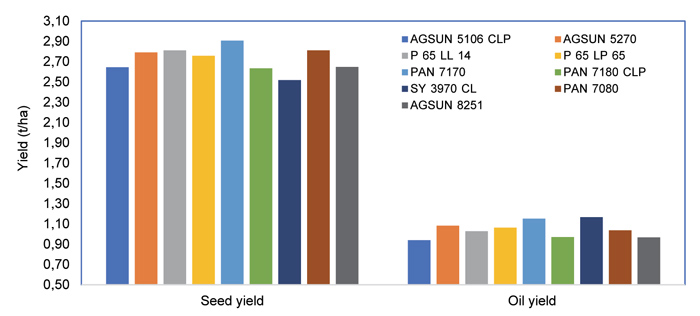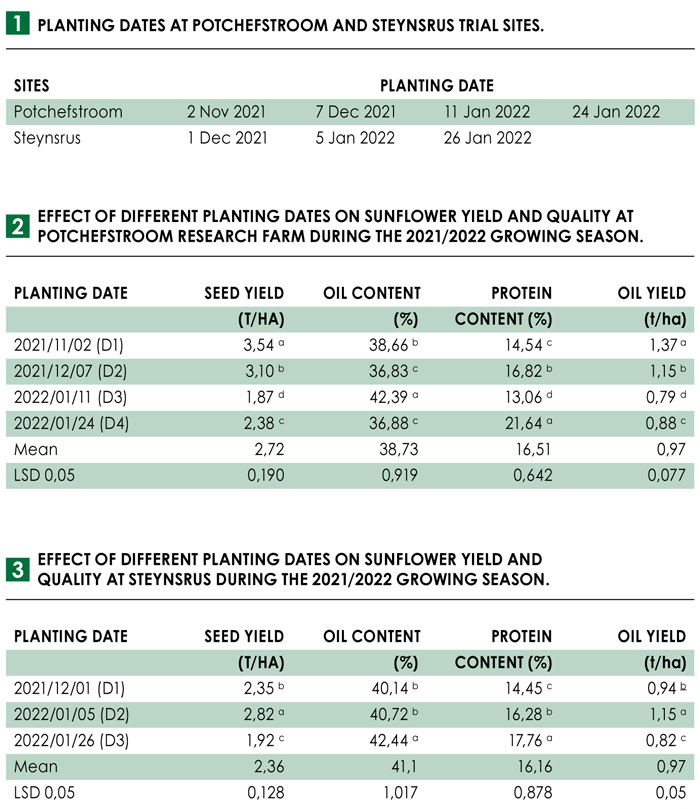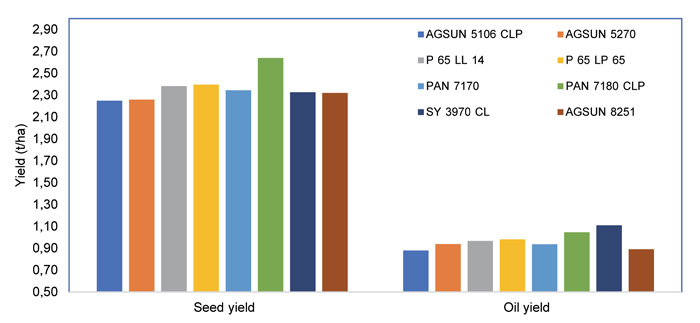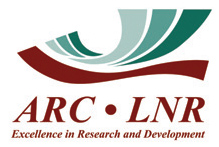
Sunflower is often used as a catch crop and is planted as an alternative when rainfall onset is too late for maize or soybean plantings. Therefore, the stable yields under these late planting conditions are well below the crop’s yield potential.
Late sunflower plantings are more likely to encounter adverse conditions during their development, including seed/seedling exposure to high December/January temperatures, and pollination or seed development occurring under rapidly decreasing temperatures. To maximise the use of natural resources, optimum planting time of a crop is very important as it ensures good seed germination and optimum root system development. This, in turn, enables the plant to absorb essential nutrients from a large volume of soil. Sunflower grain and oil yields are greatly reduced when normal planting dates are delayed.
To promote the optimum planting dates, four field trials at ARC-Grain Crops’ Potchefstroom research farm and three field trials at Steynsrus were conducted to evaluate the effect of different planting dates (early, optimum and late planting date) on selected sunflower parameters (Table 1). The following hybrids (AGSUN 8251, AGSUN 5106 CLP, AGSUN 5270, P 65 LL 14, P 65 LP 65, PAN 7170, PAN 7180 CLP, PAN 7080 and SY 3970 CL) were evaluated in Potchefstroom in a randomised complete block design with three replications. The same hybrids (except PAN 7080) were evaluated in the same manner at Steynsrus. After maturity, four rows with 8 m length were harvested by hand to measure the grain yield per plot, grain yield measured and corrected at 9% moisture content. Sunflower seed samples were taken from each subplot for oil and protein analysis on an ‘as is’ basis. Statistical analysis was carried out on the yield and quality parameters using the SAS program.
Results obtained
Precipitation
The total recorded precipitation at Potchefstroom for the period October 2021 to May 2022 was 850 mm, which is higher than the long-term average of 634 mm. Most of the precipitation occurred during December 2021, January 2022 and April 2022 with 39 days of rainfall exceeding 5 mm. At Senekal (Driepan, the nearest weather station to the Steynsrus site) the total precipitation was 1 048 mm, with December 2021 and April 2022 receiving the highest amount of rainfall (286 mm and 154 mm) respectively.
Mean effect of planting dates and hybrids on sunflower yield and quality
Potchefstroom
Planting dates significantly affected seed yield, oil content, protein content and oil yield, whereas sunflower hybrids significantly affected all studied parameters except seed yield. First planting date planted (2 November 2021) yielded the highest seed yield (3,54 t/ha), followed by the second planting (7 December 2021) with 3,10 t/ha. The lowest seed yield was recorded for the third planting date (11 January 2022), which can be attributed to high precipitation that caused waterlogging and subsequent poor sunflower growth and development. The late planting (24 January 2022) produced a surprisingly good seed yield (2,38 t/ha). The third planting date recorded the highest oil content (42,39%) across hybrids, with the second planting date yielding the lowest oil content (38,66%). Protein content ranged from 13,06% for the third planting to 21,64 % for the last planting. Oil yield is the result of seed yield multiplied by oil content and ranged from 0,79 t/ha for the third planting to 1,37 t/ha for the first planting (Table 2). Seed yield and oil yield decreased about 33% and 0,36% respectively when the planting date was delayed until 24 January 2022.
Mean seed yield across hybrids and different planting dates was 2,72 t/ha. PAN 7170 produced the highest yield of 2,91 t/ha followed by PAN 7080 and P 65 LL 14. The lowest yield of 2,52 t/ha was recorded by SY 3970 CL. Tested hybrids showed significant differences for oil yield, with SY 3970 CL producing the highest oil yield of 1,17 t/ha, followed by PAN 7170 (1,15 t/ha) (Graph 1).

The highest oil content on an ‘as is’ basis was recorded for SY 3970 CL (46,77%) followed by PAN 7170 (44,11%). The highest protein content was recorded by AGSUN 5106 CLP (17,97%) followed by AGSUN 8251 (17,42%). At the Potchefstroom site, no significant interaction between planting date and sunflower hybrids was dedicated for seed and oil yield. However, there was a significant interaction for oil content. SY 3970 CL produced the highest oil content under all planting dates. For the first planting P 65LP 65 came second after SY 3970 CL, whereas for the second planting PAN 7170 was second. For the third planting P 65 LL 14 was second, while for the last planting AGSUN 5270 was second after SY 3970 CL.
Steynsrus
Planting date and sunflower hybrids significantly affected all studied parameters. The second planting date (5 January 2022) recorded the best seed yield and oil yield (2,82 t/ha and 1,15 t/ha) respectively. The last planting date (26 January 2022) yielded the lowest seed yield and oil yield of 1,92 t/ha and 0,82 t/ha respectively. A lot of rain fell directly after the December planting (the first planting date), which had a negative effect on both seed germination and seedling establishment. The last planting date produced the highest oil content (42,44%), whilst no significant differences were observed between the first and the second planting for the same parameter. The highest protein content (17,76%) was recorded for the last planting date followed by the second planting. The lowest protein content (14,45%) was recorded for the first planting date (Table 3).
 The sunflower hybrids evaluated differed significantly for all parameters evaluated. PAN 7180 CLP produced the best mean seed yield (2,64 t/ha) across all planting dates. The seed yield mean across hybrids and planting date was 2,36 t/ha, which is 15% less than the yield at the Potchefstroom site (2,72 t/ha). Oil yield mean was 0,97 t/ha, which is 8% less than Potchefstroom’s mean (1,05 t/ha). SY 3970 CL produced the highest oil yield (1,11 t/ha) followed by PAN 7180 CLP (1,05 t/ha) (Graph 2).
The sunflower hybrids evaluated differed significantly for all parameters evaluated. PAN 7180 CLP produced the best mean seed yield (2,64 t/ha) across all planting dates. The seed yield mean across hybrids and planting date was 2,36 t/ha, which is 15% less than the yield at the Potchefstroom site (2,72 t/ha). Oil yield mean was 0,97 t/ha, which is 8% less than Potchefstroom’s mean (1,05 t/ha). SY 3970 CL produced the highest oil yield (1,11 t/ha) followed by PAN 7180 CLP (1,05 t/ha) (Graph 2).

Average oil content was 41,10%, which is 6,4% more than the average oil content at the Potchefstroom site. SY 3870 CL produced the highest oil content (47,63%), followed by AGSUN 5270 (41,67%). SY 3970 CLP produced the highest protein content (17,52%), followed by AGSUN 8251 (19,95%). At the Steynsrus site, the sunflower hybrids reacted differently under different planting dates for all parameters except the oil content. Under first planting PAN 7180 CLP produced the best seed yield, followed by PAN 7170, and under second planting dates PAN 7180 CLP produced the best seed yield, followed by P 65 LL 14. AGSUN 8251, followed by AGSUN 5270, performed the best under late planting. SY 3970 CL produced the highest oil content under all planting dates. However, for the first planting date SY 3970 CL performed the best, followed by PAN 7180 CLP, while for the second planting PAN 7180 CLP was followed by SY 3970. For late planting AGSUN 5270 performed the best, followed by AGSUN 8251.
Conclusion
The current project commenced with an exceptional first growing season, marked by very high precipitation at both trial sites. Planting date had a significant effect on all studied parameters. At Potchefstroom, the November and December planting dates on average resulted in higher seed and oil yield, and the late planting date (January) had the lowest seed and oil yield. At Steynsrus, planting in the first week of January on average produced the highest seed and oil yield, whereas planting in the last week of January produced the lowest seed and oil yield. Sunflower hybrids also performed differently at varying planting dates for all parameters, except seed and oil yield at the Potchefstroom trial sites. On average, PAN 7170 and PAN 7180 CLP produced the highest seed yield at Potchefstroom and Steynsrus respectively, whilst SY 3970 CL produced the highest oil content and oil yield at both sites. On average, oil and protein content were more hybrid-related than planting date-related, while seed and oil yield were more affected by the planting date.





























